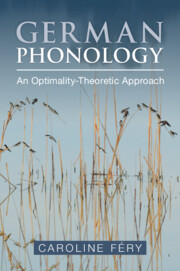Book contents
- German Phonology
- German Phonology
- Copyright page
- Contents
- Figures
- Tables and Tableaux
- Preface
- Abbreviations
- 1 Introduction
- Part I Lower Prosodic Constituents: Moras, Syllables, Feet
- 2 The Sounds of German
- 3 Syllables and Moras
- 4 Segmental Alternations
- 5 The Foot
- 6 Schwa and Syllabic Sonorants
- Part II The Higher Prosodic Constituents: Prosodic Words, Prosodic Phrases and Intonation Phrases
- References
- Index
- List of Constraints
2 - The Sounds of German
Phonemes, Allophones and Distinctive Features
from Part I - Lower Prosodic Constituents: Moras, Syllables, Feet
Published online by Cambridge University Press: 04 January 2025
- German Phonology
- German Phonology
- Copyright page
- Contents
- Figures
- Tables and Tableaux
- Preface
- Abbreviations
- 1 Introduction
- Part I Lower Prosodic Constituents: Moras, Syllables, Feet
- 2 The Sounds of German
- 3 Syllables and Moras
- 4 Segmental Alternations
- 5 The Foot
- 6 Schwa and Syllabic Sonorants
- Part II The Higher Prosodic Constituents: Prosodic Words, Prosodic Phrases and Intonation Phrases
- References
- Index
- List of Constraints
Summary
This chapter first outlines a traditional phonological approach to the description and classification of segments. It introduces the “phoneme,” a notion of structuralism (i.e., the contrastive and distinctive segments of individual languages that form minimal pairs). The approach is a functional one: Phonemes are not only characterized by the sum of their features but also by their concrete allophones. Different kinds of allophonies are introduced with different sounds of German. The second part proposes a system of distinctive features for Standard German. Except for the major class features and the binary feature [±back], consonants and vowels are accounted for by different features. The role of distinctive features in cross-classifying segments as well as in building natural classes is discussed in some detail. Features are represented in a non-linear feature geometry, illustrated in the chapter for individual segments, both simple and complex, and in phonological processes such as assimilation and feature deletion. The chapter also contains a non-exhaustive proposal of how the feature system of German is accounted for in OT.
Keywords
- Type
- Chapter
- Information
- German PhonologyAn Optimality-Theoretic Approach, pp. 27 - 76Publisher: Cambridge University PressPrint publication year: 2025

